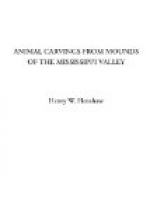To carry the imitative idea farther and to suggest, as has been done by writers, that the carver of the Mound-Building epoch sat down to his work with the animal or a model of it before him, as does the accurate zoological artist of our own day, is wholly insupported by evidence derivable from the carvings themselves, and is of too imaginative a character to be entertained. By the above remarks as to the lack of specific resemblances in the animal carvings it is not intended to deny that some of them have been executed with a considerable degree of skill and spirit as well as, within certain limitations heretofore expressed, fidelity to nature. Taking them as a whole it can perhaps be asserted that they have been carved with a skill considerably above the general average of attainments in art of our Indian tribes, but not above the best efforts of individual tribes.
That they will by no means bear the indiscriminate praise they have received as works of art and as exact imitations of nature may be asserted with all confidence.
PROBABLE TOTEMIC ORIGIN.
With reference to the origin of these animal sculptures many writers appear inclined to the view that they are purely decorative and ornamental in character, i.e., that they are attempts at close imitations of nature in the sense demanded by high art, and that they owe their origin to the artistic instinct alone. But there is much in their general appearance that suggests they may have been totemic in origin, and that whatever of ornamental character they may possess is of secondary importance.
With, perhaps, no exceptions, the North American tribes practiced totemism in one or other of its various forms, and, although it by no means follows that all the carving and etchings of birds or animals by these tribes are totems, yet it is undoubtedly true that the totemic idea is traceable in no small majority of their artistic representations, whatever their form. As rather favoring the idea of the totemic meaning of the carvings, it may be pointed out that a considerable number of the recognizable birds and animals are precisely the ones known to have been used as totems by many tribes of Indians. The hawk, heron, woodpecker, crow, beaver, otter, wild cat, squirrel, rattlesnake, and others, have all figured largely in the totemic divisions of our North American Indians. Their sacred nature too would enable us to understand how naturally pipes would be selected as the medium for totemic representations. It is also known to be a custom among Indian tribes for individuals to carve out or etch their totems upon weapons and implements of the more important and highly prized class, and a variety of ideas, superstitious and other, are associated with the usage; as, for instance, in the case of weapons of war or implements of the chase, to impart greater efficiency to them. The etching would also serve as a mark of ownership, especially where property of certain kinds was regarded as belonging to the tribe or gens and not to the individual. Often, indeed, in the latter case the individual used the totem of his gens instead of the symbol or mark for his own name.




